Socioeconomic Influence on Landscape Architecture
Chapter 1: Introduction
Over the past two decades, Landscape Architecture designs have started to capture one’s attention, and there is a change in trends because of the shifts in the perceptions of the professionals. Landscape Architects are one of few professions which give solution to climate-positive designs. Landscape architecture designs are affected using several factors like change in climate, financial investments, the social-economic status of the person, etc. This study aims to analyse if the experience of Landscape Architecture designs changes by a person’s socio-economic status. In this study, socio-economic factors like Occupation, education, and Income will be taken into consideration. The research question associated with this study is: Does the experience of a Landscape Architecture design change by a person’s socioeconomic status, i.e., Occupation, Education, and income. This study is the rationale as very few researches have been made, which is linked with the impact of socioeconomic status upon Landscape Architecture design, whereby I can attain benefits from it.
Chapter 2: Literature review
2.1 Landscape Architecture
Foster (2010) has stated that Landscape Architecture is the designing of the structures, landmarks, and other public areas to attain socio-cultural, environmental, and aesthetic results. It possesses the examination of the ecological, social, and geological conditions in the landscape. It is a multi-disciplinary area that possesses aspects such as horticulture, botany, geology, geography, ecology, and many others, which affects archaeology. The landscape architecture activities in the urban conservation project consists of designing of public parks and parkways, site planning, and management of larger areas. Landscape Architecture review different types of structures that are either larger or smaller and are made up of either hard or soft material (Vroom, 2016). The generation of the ideas, along with acknowledgment for organizing designs and usage of space, are some of the vital contributions made by this architecture approach. The primary purpose of the business of Landscape Architecture is to attain beauty and utility in the outdoor environment. In order to fulfil this viewpoint, the layout of the construction is considered and reviewed if it is functional and practical and composed artistically or not. The smooth and convenient functioning of the design is also considered to fit the topography (Motloch, 2011).

2.2 Factors of architectural designs
As per Nasir, Ahmad, and Ahmed (2013), Landscape Architecture such as building architecture is linked with certain factors of models like scale, proportion, colour, emphasis, unity, and contrast. The range is known as the size of the building parts like windows and doors, which is linked with uses and purposes. Since buildings are made for the usage of people, so scales are selected similarly. The designing scale is considered as per the requirement of the human beings wherein certain parts are made as per the building standards. The landscape might vary as per the purpose wherein in the garden; the pieces are made of a smaller scale. However, the landscaping of the government building requires more extensive and impressive buildings. It is thus analysed that levels of the public and essential landscape are much larger than the domestic scene, but the scale cannot be uniform and same throughout the architecture process (Foster, 2010). Unity is another factor that is considered while landscape designing. It is reviewed that various parts of the designs need to be united and must showcase their purposes in harmonious compositions. It is necessary for the landscaping and building to make harmonious output when the Biophilia is just as important as the building. Proportion is another factor that is associated with the link between the shape of different features and parts of the landscape. It is stated that there needs to be a smooth link between the macro, messo and micro scale designs. The colour pallet is also considered wherein it needs to be harmonious despite the used materials. The colour of the landscape should be in harmony with the building adjoin with it to enhance the beauty of the architecture building (Nasir, Ahmad, and Ahmed, 2013).
As per Kapper and Chenoweth (2010), it is further essential for the architect to review the contrast in the Landscape designs. It must not be apparent to generate inharmonious outputs or affect the design’s unity. The differences could be attained in various size, colour, texture, and forms. It acts as the means to add value and beauty to the designs. The architect of the landscape gives significant emphasis on the fulfilment of the needs of the clients. (Kapper and Chenoweth,2010).
2.3 Different methods of designing
System modelling, environmental relation, and anthropometric analogies are the three different methods of designing Landscape Architecture. They are explained below.
System modelling is the designing process that resolves the designing by reviewing the system, acknowledging the function and stimuli as well as placing the order and substituting the elements of designing. For instance, during the time of designing a plaza, the designer review crowd as water moving with tides. They even make management strategies of the groups like the controlling of the movement of the water (Lawson, 2015).
Environmental relations possess a direct relationship between human beings and the environment. The designers even acknowledge on how materials make interaction with the environment and further make the decision regarding the construction of the landscape. The landscape architects generally incorporate the plants and other designing tools in the designs to minimize the impacts of the environment on the projects (Zube & et al., 2010).
Anthropometric analogies are another method that is applied in the designing of landscape architecture. This method generally gives focus on the body of humans and its link with the goals of designing. Since there is a baseline relationship prevailing in between the human body and designs, so the designers need to make designs that are related to the sites. For instance, it is reviewed by the designers if the bench or other designing models are comfortable or not (Thompson, 2008).
2.4 System theory in Landscape Architecture
According to Murphy (2015), System theory is the theory that possesses a distant perspective to landscape and review the objective of the scene. It is acknowledged that Landscape Architecture is linked with the function, process, and structure of the stage. System theory gives a framework to understand and explain the conditions of human relationships with the environment. The understanding of the system is done when the single sets are taken as unit elements, and assembly of features constitutes a whole system (Lawson, 2015). The system is termed as the whole which possesses entities and relationship which works through part’s interrelatedness and possess properties which are not dependent on the components. This theory states that the behaviours of every element of systems possesses an effect on the functioning of the whole system. It is also noted that the action of the aspects of the system and its impact on the entire operations are not dependent on one another (Thompson, 2008). lastly, this theory also reveals that systems of elements are interconnected in such a manner that there is no possibility of the formation of independent subgroups. The system theory provides uniform knowledge and is mostly dependent on the fundamental principle of design thinking.
2.5 Socio-economic impact on the landscape architecture designing
According to Simonds & et al. (2016), The building of the architectural landscape always has its effects on the society and communities around it. The increase in population has enhanced the space and structure, which influence the viewpoints of the people towards the designs. It is found that when factors like education, income, and occupation have come up as a major contributor to change the mindset of the people towards the landscape. When the people are educated, then they possess innovative perception towards the whole architecture designs, and there are fewer chances of criticism (Treib, 2011). The educated and occupation -field people, even perceive these activities as a source of economy which can enhance the situation of the market. Moreover, educated people who perform the job and possess a good sum of income even understand the environmental impact of the architectural landscape designing and thus take necessary measures to mitigate the issues associated with designing (Zube & et al., 2010).
The social-economic aspects such as education also assist the Landscape Architect in applying only those materials which do not emit any sorts of toxic substances and gases in its environment (Treib, 2011). The effective education and income of the Landscape Architecture even motivate them to make the usage of energy efficiency technology, so that there is lesser usage of energy and conserve the usage of energy. It is stated that when the customers who have ordered the Landscape Architecture are educated and possess a good sum of income through their occupation, then those customers will always prefer to apply sustainable systems in its design to minimize the destruction of the environment(Simonds & et al., 2016). However, it is also observed that when there is a lack of education, income, and well-organized occupation of customers, then they do not give emphasis on social and environmental aspects but only review upon the design and colours. This results in instability and unsustainability in the environment (Karmanow, 2009).
Chapter 3: Methodology
Since my research aims to analyse if the experience of a landscape architecture designs changes by a person’s socioeconomic status, a in-depth analysis will be done to attain a solution. This study will consider qualitative research methods that will effectively describe, interpret, contextualize, and even gain in-depth insight regarding the concept. This method makes the usage of non-numerical data and does not focus on statistical data. The secondary data in this study will be collected using journals, books, academic papers, etc. wherein primary data will be gathered using the interview. To attain practical insights, a structured interview will take place with 5 landscape Architects. The interview participants will belong to the age groups of 20-40 years old, wherein systematic sampling will be used to select the Landscape Architect. This structured interview will possess a series of pre-determined questions wherein all interviewee's answers will be in the same order. This method will be used to choose the samples as it is cost and time effective and is effective in collecting data (Crowther & Lancaster, 2009). However, business is one of the major disadvantages of this sampling. Interviews will be conducted in an office type environment, wherein it will last for approximately 20 minutes for each participant. 10 questions will be asked to the respondents wherein 8 questions will be open-ended, and 2 question will be closed ended. Face-to-face interview will be executed wherein answers will be recorded by means of notetaking.
In addition to that, my study will apply interpretivism philosophy to interpret how individuals observe the activities. This philosophy is applied as it makes the usage of diverse approaches for the investigation of the research study. Moreover, since this study apply qualitative methods so inductive approaches are applied, which gathers data and makes the development of theory analyse effective outcomes of data that start from theories. My study will further apply exploratory research so ad to explore the research question, which will help in the practical understanding of the problem. Although, this research design will not provide final and conclusive answers to the research question but will explore the research topic in-depth (Sallee & Flood, 2012). Both primary and secondary data collected will be analysed by means of the data analysis tool. The collected numeric information, such as survey questionnaire data, has been analysed using graphs and charts. This method will categorize verbal and behavioural data so as to classify, summarize, and even tabulate the data. Ethical consideration is one of the essential parts of the research wherein, in this research, none of the participants will be subjected to harm. The dignity of the research participants will be respected and will be prioritised wherein full consent will be attained from participants. The privacy of the research participants will be ensured, and research data will be kept at the higher intimate level. All the secondary data will also be collected from sound and academic sources, and none of the data will be taken from outside of these sources.
Chapter 4: Survey Questionnaire
In this section of my study, the focus has been mainly on analysing the data that has been collected from the questionnaire survey with target respondents. It needs to be mentioned that as much as 50 respondents have been considered in this research and have been sampled through the random sampling technique from the industry. The data collected has been presented using graphs, charts, and pie and is discussed extensively as a part of gathering relevant data and attaining the objective of the research.
Disclosure:
In light of the current Covid 19 Pandemic the results are not a true reflection of the people involved, so therefore it is said that focus should be on the format of my research paper and not the exact data inputted.
4.1. Data Presentation
In the first question of the survey, the respondents were asked regarding their occupation along with some options to choose from for them. The following responses have been gathered for this particular question.
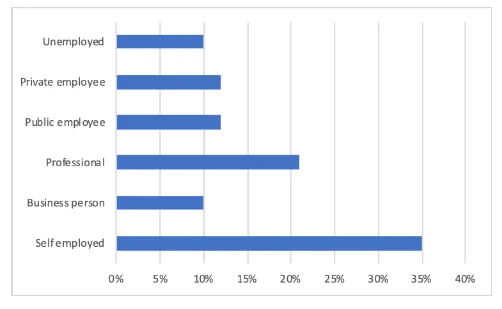
It is notable from the graph above that as much as 35% of the respondents are self-employed while another 21% of the people associated in this survey are professionals. In a similar context, public employees and private employees are identical in number for this survey, with figures of around 12% each. Hence, it is apparent of the findings for this question that most of the people are either self-employed or businessperson.
In the next question of the survey, the respondents were regarding their educational qualifications with options such as secondary education, higher secondary educations, and bachelor's and master’s degree, among others. The following responses have been gathered for this particular question.
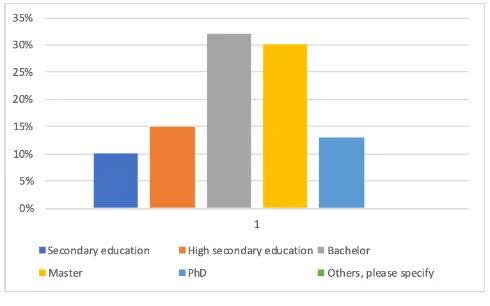
As per the responses acquired and presented in graphs above, it is clear that a high number (32%) of respondents have a bachelor’s degree for themselves while 30% of the respondents told during the survey that they have a master’s degree. Again, in a similar context, as much as 15% of the respondents have claimed that they have a higher secondary degree to their name with another 13% are having a Ph.D. degree according to their responses. Hence, it is clear from the data received that master’s degree and bachelor’s degree are among the essential educational qualification of the respondents that have taken part in my research study.
In the next question of my survey, the respondents were asked regarding the level of their income, for which the following responses have been accumulated. It is noted that a specific range of options has been provided to the respondents for this question as it is complicated to anticipate an exact amount and put it in a questionnaire.
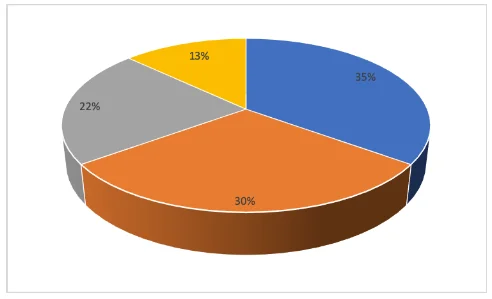
As per the responses provided above, it is clear that as much as 35% of the respondents have an annual income between the range of less than £20,000 per annum. This was also the lowest amount option that was provided in the questionnaire. Again, it is to be said that around 30% of the respondents claimed their income to be in the range of £20,000 to £50,000 per annum. As much as 22% of the respondents have depicted their income to be in the field of £50,000 to £100000 per annum. Hence, it is apparent that most of the respondents fall in the income below £20,000.
In the next question of my survey, the respondents were asked regarding the size / occupancy of the household in which they live. For this, the following responses have been acquired and presented graphically.

As per the responses, it is clear that 32% of the respondents live in a house that can accommodate two to three persons and can be deemed as equivalent to a 3 bedroomed house. In a similar context, around 28% of the respondents claimed that they live in a house with Four to five persons, which can equivalent to a 5 bedroomed house apart or home according to the understanding of my research. Around 26% of the people noted that they live in a house with More than five persons. Hence, the data acquired shows that most of the respondents reside in medium sized houses.
In the next question of the survey, the respondents were asked to specify their house, excluding the kitchen and bathroom. Correspondingly, the data acquired for this particular question has been presented graphically hereunder.
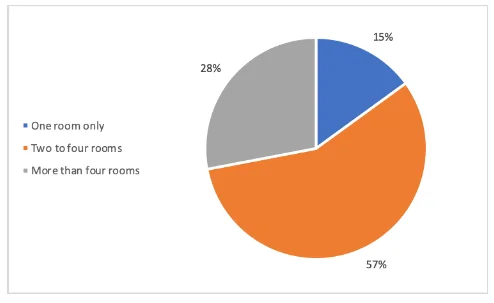
The data acquired shows that a maximum of (57%) live in a house with two to four rooms apart from the kitchen and bathroom. Again, another 28% has depicted that they live in a house with More than four bedrooms apart from the kitchen and bathroom. Around 15% of the respondents have determined that they live in a house with around one room alone from the kitchen and bathroom. Hence, it is apparent that most of the respondents live in a house with two to four bedrooms.
In the next question of my survey, the respondents were asked about specifying the garden design they prefer in their respective houses. For this, the following responses have been gathered and presented graphically hereunder.
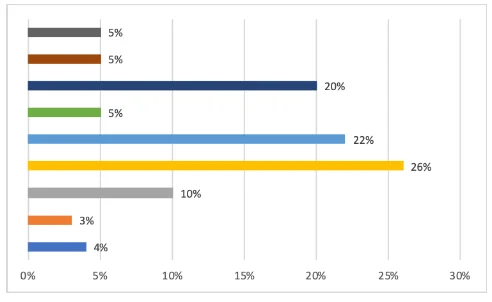
As per the responses acquired, around 26% of the respondents depicted that they would prefer a naturalized garden in their house backyard. In a similar context, about 22% seen to be favouring a grass garden in their backyard. Another 20% of the respondents are deemed to be preferring Trees in their home garden. It is worthwhile to note that 10% of the respondents prefer imported species garden in their backyard, which is quite innovative and surprising.
In the next question of my survey, the respondents were asked about the type of garden they prefer in their respective with two options to choose from. The following responses have been accumulated in this context.
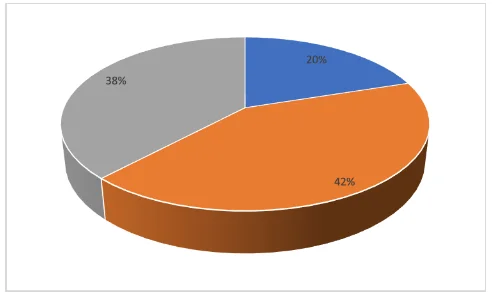
As per the responses gathered in this regard, it has been noted that around 42% prefer their home to be in Mediterranean style. In a similar context, 38% determined their preferred choice for garden type to be urban, while another 20% of respondents have selected a wildlife friendly to be the preferred style of their garden type in the house. Hence, it is clear that the Mediterranean and Urban style are quite a popular type of gardens choice amongst the respondents.
In the next question of the survey, the respondents were asked about the landscape design they prefer with regard to their respective home and garden. For this, the following responses have been accumulated.
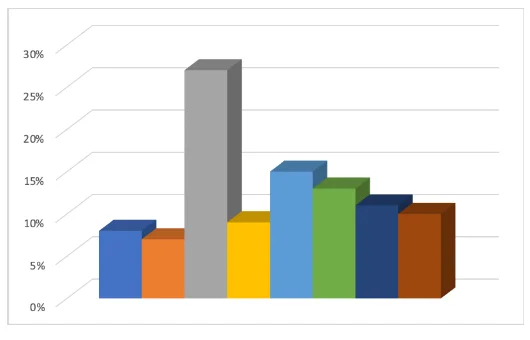
As per the responses in the above graph, it is clear that 27% of the respondents prefer to have a Woodland landscape in their homes. Again, 15% of the people determined that they would prefer to have an Informal Landscape scene in their respective houses. Around 13% of the respondents prefer to have a Butterfly garden in their homes, which is not quite common in terms of personal living and residence of people, and it might also cost higher in terms of management and installation as compared to other forms of house landscape. Again, around 10% of the respondents had a unique preference of Organic garden within their residence. It is unique owing to its high maintenance and complication involved. In a similar context, around 8% prefer to have a traditional English garden style in the landscape of their respective homes. Hence, it is apparent that the choices of the people are quite diverse.
In the next question of my survey, the respondents were asked about their choices or preferences in terms of Landscape Architecture within their respective household vicinity. Notably, a diverse range of responses has been gathered for this question, and the following graphical evidence can be an excellent presentation of the same.
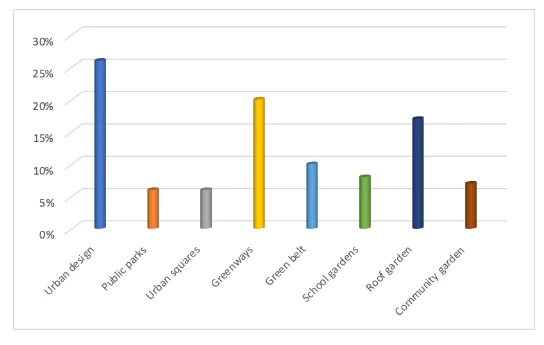
As per the data acquired, it is clear that around 26% of the people tend to prefer the urban design around their household since, in the modern age, people are more inclined towards creative and updated models. Again, around 20% of the respondents have depicted that greenways are the way ahead in terms of landscape architecture. Along with this, 17% of the people have selected roof gardens as their preferred choice, which also shows the likeability of this particular option. 10% of the respondents feel that the green belt land is among the best natural landscape Architecture design in the contemporary era. Hence, the choice of people is quite diverse, and they are also deemed to be well equipped with all the knowledge regarding modern architecture.
In my final question of my survey, the respondents were enquired about the essential services they prefer to have near to their respective households. The following responses have been gathered.
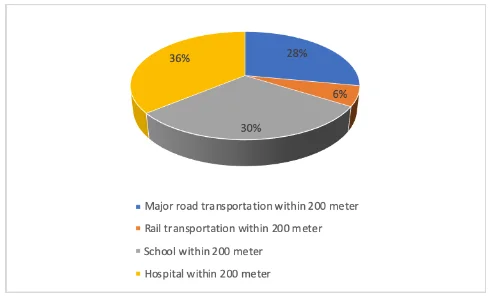
Around 36% of the respondents have preferred to have a hospital, which is 200 meters within their homes. This is a sensible choice considering the importance of health and wellbeing in the current era. Another 30% of the respondents have preferred to have schools 200 meters to their home, while 28% of the respondents have selected major road transportation 200 meters from their home to be their choice. 6% of the respondents have chosen the option of having rail transportation 200 meters from their home.
4.2. Discussion of Survey Findings with Literature Findings
In this particular section of my study, the focus has been mainly on analysing the findings of both the literature search and the survey findings. It is notable that this particular research study largely contributes towards comprehending the impact of socio-economic impacts upon the experience of landscape architectural design. Researches of Motloch (2011) and Vroom (2016) has determined that landscape architecture mainly relates to designing of structure, areas, and landmarks to get a view of aesthetics in social and environmental level. Landscape architecture can be of different forms depending on the Landscape or regions in which it is situated. While building a particular landscape, it is essential to make sure that the careful, economical, and social balance is being created in the process. This study focuses on understanding the change in experience or impact that socio-financial status-related factors like occupation, education, and income have upon the people. In this context, the survey responses showcase a good comprehension of the social status of the people that is determined based on their income and living standards. As much as 35% of the people involved in this research are self-employed and have quite a unique taste concerning architecture and landscape design. The job and employment status of people also has a significant contribution in terms of determining how people perceive landscape Architecture design.
As per the literature search, it has also been noted that various factors influence architectural design in the present scenario. Some of the studies, including Nasir, Ahmad, and Ahmed (2013), Foster (2010), and Kapper and Chenoweth (2010) has determined that building of architecture is linked with various design elements of a particular structure. This can include aspects such as colour, texture, garden, landscape, and others. The size of the structures and windows are termed under the scale of the structure as per the past studies conducted on this subject. In modern-day architecture, the role of design elements is deemed to be extremely prime to assure that people are satisfied with the structures they get in their day to day living. Design elements within modern-day buildings are also essential in context to the uniformity of the overall process of architectural development among the people at large.
Furthermore, studies have added that unity or balance in the design of architecture while designing landscapes has also depicted suitable properties in this particular sector. In this regard, the findings chapter has also described a specific dataset that shows the abilities of people to differ between a diverse range of designs. 32% of people with bachelor’s degree has taken part in this research study, while 30% claimed to be holding the master’s degree. Educational qualifications of people are deemed to be important in the field of architecture as it helps in understanding design, shapes, and scale differently. It is also noted that educational qualification is essential to understand the difference between right and wrong in terms of design, scale, and idea of a particular style of landscape architecture. Educational qualification is also an essential element to provide an understanding with regard to the choice that people make in terms of architectural designs as numerous technical elements are linked with such knowledge. Hence, the impact of educational qualification associated with landscape architecture is quite apparent in this context.
Past researches of Lawson (2015), Zube & et al. (2010), and Thompson (2008) have suggested that there are different methods of designing that exits within the industry of Landscape Architecture. Most notably, the studies have mentioned system modelling; environmental relations, along with anthropometric analogies, are among the significant methods of designing that is prevalent within the industry. Each of the designs is made with a specific objective to evaluate models of different kinds that are in use within this industry sector. Each of the methods mentioned above has its own set of comprehensions and help in understanding or exploring a particular element of Landscape Architecture design. In this regard, various factors have been discussed in terms of designing Landscape Architecture within the survey findings of my research. The respondents were enquired about different sorts of designs that they would prefer in their respective houses or surrounding spaces. Most people with two or three rooms house have responded along with master and bachelor’s degree has provided their opinion regarding different design elements. As much as 26% of the respondents have noted that they would prefer a woodland Landscape garden design within their respective residence. 22% of the respondents have shown or discussed their preference for having grass in their garden. In terms of the types of the type of gardens preferred, the respondents have claimed that Mediterranean and an urban style garden are most attractive to have in their designs. This also shows that people need to have proper knowledge regarding the plans that are in extensive use. This can be knowledge regarding elements of ideas or the designs of the overall garden or a particular space in concern. Apart from education, the role of income level is also deemed to be important in the architectural landscape. Most notably, the people that have taken part in the research study within the survey process are well-earning people and people living in a house with three or four rooms apart from the kitchen and bathroom. This information presents an understanding of the social positioning of a particular individual, and it further depicts his/her capacity of affordability. These aspects also enable individuals first to understand a specific design and then expect a particular service from companies based on their social status and income level. When the respondents were given different design elements for the architectural landscape, they had the knowledge or the ideas to select what they need. Also, income, education as well as social status are equally important and influencing factors in the choice made by people towards architectural designs.

Chapter 5: Conclusion and Recommendation
5.1 Conclusion
This study is regarding Landscape architecture, which design landmarks, structures, and public areas to attain required socio-cultural and environmental results. It had been analysed that various factors affect architectural designs such as proportion, colours, scale, contrast, and unity. The architect of the landscape is giving significant attention to the client’s needs. This study has analysed that there are different methods of designing landscape architecture, which includes anthropometric analogies, system modelling, and environmental relation. The anthropometric techniques are applied in landscape architecture’s designing, wherein environmental relation methods make the usage of plants and planning tools. This study has further explained system theory, wherein it explained regarding distant perspective to landscape and attain landscape objectives. It had been analysed that this theory reviews the conditions of human relationships along with the environment. This theory even explains that the element’s behaviour upon the system has a direct impact on the whole system. It had further been analysed from this study that the building of the Landscape Architecture possesses its effects on the community and society. Various socio-economic impacts are affecting the designing of landscape architecture. It had been reviewed that education, occupation, and income are found to be the main contributor to the changing of the people’s mindset regarding landscape. It had been analysed from the whole study that when the client is educated then they possess different perceptions towards the Landscape architectural designs wherein they would prefer to use innovative and sustainable technology rather than using traditional techniques of building designs. Further, my study has analysed that job-oriented people even had different perceptions regarding money they have to spend on designing. Since designing the architectural building needs a larger sum of money, the job-oriented are capable of paying that source of money upon these activities as compared to unemployed people. The occupation is a factor that not only assists the people to attain cash but also provides power to the people to apply new and innovative technology in its building. It is further analysed that those people who are educated and possess good income occupations even have consciousness regarding their social status. This, in turn, make these people stay conscious regarding their situation wherein Landscape Architecture plays a significant role in enhancing one’s condition. Although it cannot be stated that uneducated, unemployed, and lower-income people do not possess an interest in the innovative sustainable design approaches. Still, it becomes hard for them to fulfil their financial needs. In such a contrast, people generally emphasize colour and variations of the designs, but sustainability is not considered. It can thus be stated after reviewing the whole study that income, occupation, and education have a direct impact upon the landscape architecture design change. This study can be concluded that since people spend a considerable amount of money upon healthy diets and other necessary activities, spending of the funds on landscape architecture design is quite robust for those people who do not possess money. The ones who have extra spending money could only think regarding sustainable design.
5.2 Recommendation
Since there is direct relationship between the physical surrounding and the people who make and use them, so it is essential for government to recognize the environmental problems associated with Landscape architectural design. It is recommended that individuals and agencies who are associated with preservation of the natural and built environment should be aware regarding the need of sustainable designs during landscape architecture. It is further a consideration that decision makers should include environmental psychologists along with Landscape Architects to give advice due to their understanding and link between people and place. It is stated that merging of the thoughts and ideas of psychologists assist the architecture and other people linked with the work to find a link between attitudes, values and behaviours of the individuals. Such knowledge would assist the Landscape Architect in successful planning, designing and management of the environment.
Since, it is analysed that education is highly required in changing the perception of the people towards the architecture building, government and education bodies should enhance the opportunity for educating people. Moreover, one subject should be included regarding the sustainable environmental architectural designing so that people analyse the importance of it from the earliest stage. Since, occupation is considered as another socio-economic factor which affects the experience and perception of the people towards the landscape architecture, it is essential for government and local government to increase the job opportunity. These could help the people to stay employed and earn higher amount of money to be spend in the Landscape architectural process. lastly, it is also stated that awareness programs should be set, and every new and established landscape architect should be trained and be made aware of sustainable landscape architecture so that every person can make innovative Landscape Architectural design.
5.3 Future scope
Although, this study is successful in analysing the research data, this study would have been more effective if I would have applied interview as data collection method rather than a survey. The interview findings would have given relevant and more precise data.
As a researcher I can take care with regards to the ethics while collecting the data from the interview participants and should not misuse their personal information. In addition to that, it is also stated that since while undertaking this research I may not have not applied time management skill in this research study, it was exceedingly difficult for the me to complete the study on time. Thus, it is state that I should manage time and work effectively by making a timetable. Lastly, it is also reviewed that since I faced issues due to the COVID 19 Pandemic it is said that the initial focus that would be required to conduct this research paper were affected. So, it is with this said that there should be some kind of consideration upon my submission.
Reference List
Crowther, D., & Lancaster, G., 2009. Research Methods A concise introduction to research in management an Oliver, P., 2003. The Student’s Guide to Research Ethics. Maidenhead: Open University Press.
Foster, K., 2010. Becoming a Landscape Architect. John Wiley and Sons, Inc, New Jersey.
Kapper, T. and Chenoweth, R., 2010. ‘Landscape Architecture and Societal Values’. Landscape Journal, Vol. no. 19, No. 2, pp. 149–155.
Karmanow, D., 2009. Feeling the landscape: Six psychological studies into landscape experience. Wageningen University, Wageningen, Netherlands.
Murphy, M.D., 2015. Landscape architecture theory. Long Grove, IL: Waveland Press.
Motloch, J., 2011. Introduction to landscape design. New York: Van Nostrand Reinhold.
Nasir, R., Ahmad, S. and Ahmed, A., 2013. Physical Activity and Human Comfort Correlation in an Urban Park in Hot and Humid Conditions. Procedia—Social and Behavioral Sciences, Vol. No. 105, No. 2, pp. 598-609.
Simonds, J.O. & et.al., 2016. Landscape Architecture: A Manual of Environmental Planning & Design, Companies. Inc McGraw-Hill.
Lawson, B., 2015. How designers think: the design process demystified (4th ed.). Oxford, Great Britain: Architectural Press.
Sallee, M. W. & Flood, J. T., 2012. Using Qualitative Research to Bridge Research, Policy and Practice. Theory into Practice, Vol. No. 51, No. 2, pp. 137-144.
Thompson, I., 2008. Ecology, Community and Delight. Sources of values in landscape architecture. London & New York: Taylor & Francis.
Treib, M., 2011. Meaning in Landscape Architecture and Gardens. Abingdon and New York: Routledge.
Vroom, M., 2016. Lexicon of garden and landscape architecture. Basel, Boston, Berlin: Birkhauser
Zube, E., & et al., 2010. "Landscape perception: research, application and theory." Landscape planning Vol. No. 1982, No. 9, pp. 1-33.
- 24/7 Customer Support
- 100% Customer Satisfaction
- No Privacy Violation
- Quick Services
- Subject Experts



